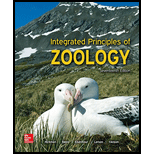
The arthropod exoskeleton is the most complex of invertebrate integuments. Describe its structure, and explain the difference in the way cuticle is hardened in crustaceans and in insects.
To describe: The structure of arthropod exoskeleton.
Introduction: Integument is considered as an outer covering of the body and it is the protective layer such as the skin and all the structures associated with or originated from the skin, for example, scales, hair, horns, feathers, and setae. The most complex invertebrate integuments possessed by the arthropods.
Explanation of Solution
Structure of the arthropod exoskeleton:
The arthropod exoskeleton comprised of a single-layered epidermis, also known as hypodermis, which secretes two different zones of cuticles. This includes procuticle and epicuticle. The procuticle is a thicker inner zone and it is made up of protein and chitin deposited in layers. Epicuticle is the thin, outer zone of the cuticle and it is lying on the outer surface above the procuticle. The epicuticle is considered as a nonchitinous complex of proteins as well as lipids that confer a protective moisture-proofing barrier to the integument.
To explain: The difference in the way cuticle is hardened in crustaceans and in insects.
Explanation of Solution
The difference in the way cuticle is hardened in crustaceans and in insects:
The cuticle of an arthropod may be a tough however flexible and soft layer, as it is in numerous microcrustaceans and insect larvae or it may be hardened in one of two ways. The cuticle in decapod crustaceans, such as lobsters, and crabs, is stiffened by calcification process.
In insects, the hardening takes place once the molecules of proteins join together with stabilizing cross-linkages within and between the adjacent lamellae of the procuticle. Sclerotization is the result of this process. Sclerotization is a process in which the formation of a highly resistant as well as insoluble protein known as sclerotin occurs.
Want to see more full solutions like this?
Chapter 29 Solutions
LooseLeaf for Integrated Principles of Zoology
- What is the structure and function of Eukaryotic cells, including their organelles? How are Eukaryotic cells different than Prokaryotic cells, in terms of evolution which form of the cell might have came first? How do Eukaryotic cells become malignant (cancerous)?arrow_forwardWhat are the roles of DNA and proteins inside of the cell? What are the building blocks or molecular components of the DNA and proteins? How are proteins produced within the cell? What connection is there between DNA, proteins, and the cell cycle? What is the relationship between DNA, proteins, and Cancer?arrow_forwardWhy cells go through various types of cell division and how eukaryotic cells control cell growth through the cell cycle control system?arrow_forward
- In one paragraph show how atoms and they're structure are related to the structure of dna and proteins. Talk about what atoms are. what they're made of, why chemical bonding is important to DNA?arrow_forwardWhat are the structure and properties of atoms and chemical bonds (especially how they relate to DNA and proteins).arrow_forwardThe Sentinel Cell: Nature’s Answer to Cancer?arrow_forward
- Molecular Biology Question You are working to characterize a novel protein in mice. Analysis shows that high levels of the primary transcript that codes for this protein are found in tissue from the brain, muscle, liver, and pancreas. However, an antibody that recognizes the C-terminal portion of the protein indicates that the protein is present in brain, muscle, and liver, but not in the pancreas. What is the most likely explanation for this result?arrow_forwardMolecular Biology Explain/discuss how “slow stop” and “quick/fast stop” mutants wereused to identify different protein involved in DNA replication in E. coli.arrow_forwardMolecular Biology Question A gene that codes for a protein was removed from a eukaryotic cell and inserted into a prokaryotic cell. Although the gene was successfully transcribed and translated, it produced a different protein than it produced in the eukaryotic cell. What is the most likely explanation?arrow_forward
 Human Biology (MindTap Course List)BiologyISBN:9781305112100Author:Cecie Starr, Beverly McMillanPublisher:Cengage Learning
Human Biology (MindTap Course List)BiologyISBN:9781305112100Author:Cecie Starr, Beverly McMillanPublisher:Cengage Learning Human Physiology: From Cells to Systems (MindTap ...BiologyISBN:9781285866932Author:Lauralee SherwoodPublisher:Cengage Learning
Human Physiology: From Cells to Systems (MindTap ...BiologyISBN:9781285866932Author:Lauralee SherwoodPublisher:Cengage Learning Anatomy & PhysiologyBiologyISBN:9781938168130Author:Kelly A. Young, James A. Wise, Peter DeSaix, Dean H. Kruse, Brandon Poe, Eddie Johnson, Jody E. Johnson, Oksana Korol, J. Gordon Betts, Mark WomblePublisher:OpenStax College
Anatomy & PhysiologyBiologyISBN:9781938168130Author:Kelly A. Young, James A. Wise, Peter DeSaix, Dean H. Kruse, Brandon Poe, Eddie Johnson, Jody E. Johnson, Oksana Korol, J. Gordon Betts, Mark WomblePublisher:OpenStax College





